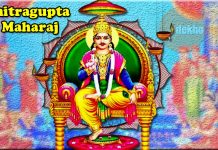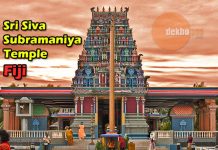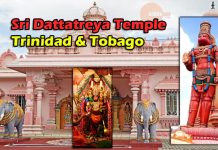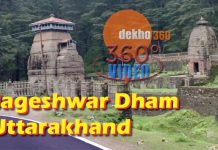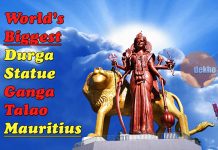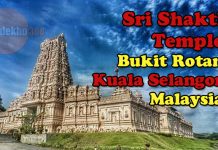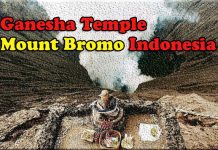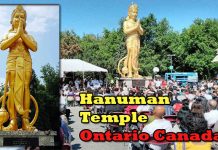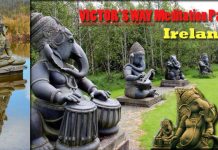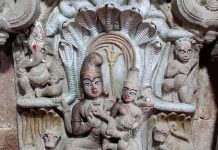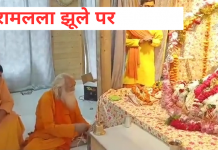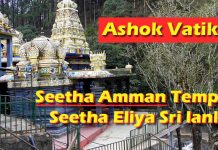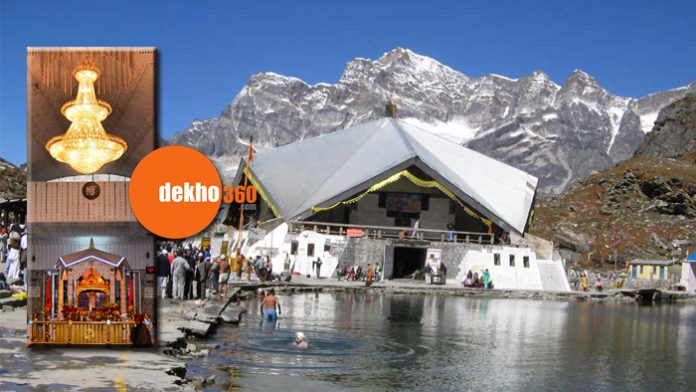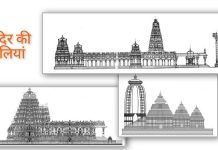Situated at a height of over 15,000 feet above the sea level in the Himalayan ranges of northern India, Sri Hemkunt Sahib or Gurudwara Sri Hemkund Sahib has emerged as a popular centre of Sikh Pilgrimage which is visited by thousands of devotees from all over the world every summer. According to Bachitra Natak, the autobiographical account of the tenth Guru, Gobind Singh, it was at Hemkunt ‘adorned with seven snow peaks’ that he meditated in his previous birth.
It was during the thirties of the twentieth century that the place was discovered by Sant Sohan Singh and Bhai Modam Singh. Bhai Vir Singh, Sikh savant and a leading figure of the Singh Sabha movement , played an important role first in helping these two gentlemen by verifying for them the location of the place and later by providing financial support for building a gurudwara at Hemkunt. Collective efforts of Sikh pioneers backed by the community support led to the construction of gurudwaras en route including Gobind Ghat (6,000 feet) and Gobind Dham (10,500 feet).
In spite of difficult terrain where Hemkunt is situated, devotees from all over the world make it to this unique Sikh shrine every summer. On the way they also visit other important gurdwaras in Rishikesh, Srinagar and Joshimath. On their way back they pay homage at Paonta Sahib, Bhangani Sahib, Tirgarhi Sahib and Shergah Sahib Gurdwaras. Apart from enjoying scenic beauty of the snow-clad peaks and taking a dip into visit the world famous Valley of Flowers not far from Sri Hemkunt Sahib.
History:
Long before the Sikhs started frequenting Sri Hemkunt Sahib,the local inhabitants of that area held the lake there with great awe and reverence and called the area around it lokpal, i.e. sustainer of people. In spite of the fact that Hemkunt was mentioned in the autobiography of Guru Gobind Singh, its site remained in oblivion for well over two centuries. This happened in spite of indication of its location having been provided been provided in the guru’s own account. It was the Sikh historian-poet Bhai Santokh Singh(1787-1843) who set his imagination to describe and elaborate the story of the Dusht daman, the name the chose for the guru (literally’ vanquisher of the evil’).
He also provided the description of his tapasthan or the place where he mediated. In the late nineteenth century , a Nirmala scholar, Pandit Tara Singh Narotam , prepared a compendium of the various Sikh pilgrim spots along with their description .That included Sri Hemkunt Sahib. On the basis of the indication provided in the Mahabharata (1:199) about the site where the pandu king had mediated. Narotam trekked up to the spot and was able to verify the site of Sri Hemkunt Sahib.
More recently, the well-known poet-historian-the ologian, Bhai Vir Singh (AD 1872-1957), carefully examined Narotam’s evidence relating to the discovery of Sri Hemkunt Sahib and accepted it to be authentic .He provided an elaborated description of spot in his biography of the tenth guru, Kalghidhar Chamatkar, employing more scientific information about the flora and fauna seen at such an attitude. However, the first person to get attracted towards the task of discovering the actual location of the tapasthan was Sant Sohan Singh (of Tehri, Garhwal ) a retired granthi from the army. He had been inspired by the description of the spot in the work of Bhai Vir Singh. He trekked up the holy spot a number of times. In 1934 , he visited the spot in the company of Baba Kartar Singh Bedi, and came back determined to set up a gurdwara there. He met Bhai Vir Singh, who also sensed that the spot that the sant with the necessary material support and furnished him with the wherewithal required for setting up a gurudwara.
The sant, along with Havaldar Baba Modan Singh, engaged a contractor and had a ten-foot square room for the gurudwara constructed there. By installing the scared volume of Sri Guru Granth Sahib in the room they had built, they established a gurudwara. In 1960, the havaldar established a seven-member trust-gurdwara Hemkunt Sahib Management Trust. The founder members of the trust were Havaldar Modan Singh , Colonel Joginder Singh Mann, S.Shamsher Singh, S.Raghubir Singh Kabaria, Baba Gurmukh Singh, S.Gurbaksh Singh Bindra and Colonel Amar Singh. This Trust not only took over the management of Sri Hemkunt Sahib but also established gurudwaras all along the path to it -in Haridwar, Rishikesh, Srinagar , Joshimath, Gobind Ghat and Gobind Dham. In all these places, the Trust steadily upgraded the facilities for the increasing number of pilgrim.
THE DESIGN – The process from Conception to Realization
The Gurdwara, the house of prayer of the Sikhs, is recognized throughout the world not only as a prominent symbol of the Sikh faith but also for its distinct style of architecture. Although certain gurdwaras adapt an architectural identity similar to the style prevalent in the country in which they are built, on the whole – they are unified in terms of architectural characteristics. The gurdwara at Hemkunt, however, is singularly unique. Its location in the lofty Himalayas, at a height of 15,210 ft., makes it the only gurdwara to be built at such an altitude. Its design, which was done keeping in mind the location and climate, makes it the only pentagonal gurdwara in the world. Further, the gurdwara at Hemkunt- the tapasthan of Dusht Daman – imparts it a high degree of respect.
The gurdwara at Hemkunt symbolizes yet another aspect… that of human effort , dedication and single -minded courage. It stands as an epitome of the human spirit that battles against obstructions to achieve its objective. The objective, here, was the building of this gurdwara and the obstructions were the undulating terrain and the harsh climate, and the human spirit – that of all the people behind the project. This chapter is an attempt to unravel the story of the effort that went behind the building of the Gurdwara at Hemkunt.
The design process involved detailed site and climatic surveys and rigorous analysis for the requirements were indeed tough parameters. The architect, Mr. Manmohan Singh Siali, rose to the occasion and delivered a design that conformed not only to the dictates of the site and climate but also to the religion itself. The resultant design was a harmonious blend of crucial factors. The success of the design can also be attributed to the far-sightedness of Gen. Harkirat Singh who was instrumental in suggesting several design factors with respect to the future.
SEQUENCE OF CONSTRUCTION
Putting up of the steel structure was the initial step as it would involve both a considerable amount of time and skill. After a certain stage, though, the steel and R.C.C. modes of construction were simultaneous.
The transport of the steel plates required for the foundation of the structure was an interesting task by itself. The foundation plates, measuring 6′ by 4′ and weighing upto 1 tonne each, were noticed by Colonel M.S. Sethi, Task Force Commander of B.R.T.P., who realized the challenge that the size of the plates would pose on the latter course of the traverse. The heavy load of the plates had to be borne manually for nearly a distance of 15 kms. and from a height of 4800 ft. upto a height of 15210ft. And that too, over a narrow and difficult bridle track which was composed of steep slopes, occurrence of steps, hair pin bends and rickety timber bridges. Col. Sethi devised a design based on the improvisation of a zing of the bends – that ‘L’ shaped angle irons which were to be bolted to the plates on both the lateral sides while keeping the plates in vertical position. Two long G.I. steel pipes (one on each side of the plate) were tied to the extended portion of the ‘L’ of the angle irons. This arrangement permitted 8 to 10 men on either side of the plate to put their shoulders to pipes raising the plate from the ground by about 18 inches and moving ahead, enabling the carriage of the five plates to their destination, much needed to be installed as the foundation plates to the steel structure. A reserve of another twenty men followed behind for replacement after short haulages. The task was completed in about ten days time.
MOCKUPS OF THE STRUCTURE
Based on the concept, the structural plans were drawn up by Mr. C.P. Ghosh – an engineer from M.E.S. and Prof. K.A. Patel from the School of Planning and Architecture. The tedious journey from Gobind Dham to Hemkunt decided the criteria for the design of the structure. A detailed study was done to adapt the sizes of the structural members and the transportation of material in accordance with the terrain. Since the lengths of the turns (Zings) varied from 3-6 m., therefore, the sections were worked out in such a way that their lengths did not exceed 2-2.5 m. This would ensure easy negotiation around the bends. Keeping this in mind, a contractor from Delhi was commissioned to manufacture their. In order to have a near perfect assemblage of these sections at Hemkunt, a mock-up of the steel structure was erected at Gurdwara Rakabgunj in Delhi. The sections were then manufacture them, duly numbered and then taken to Hemkunt.
Hemkund Sahib has a cool climate in most part of the year and the best time to visit is from June to October. Summers (June to October) have a pleasant cool weather with maximum temperature reaches to nearly 25°C. It is a good season for viewing the panoramic beauty. Winters (November to May) are snow covered and difficult to visit the outdoor attractions. Minimum temperature can go well down with average minimum about -4 °C. June to October is pleasant and ideal for the pilgrimage and also for the visit of the national park. August and September are eye catching months with blooming flowers. December to May is snow bound and road blocks prevent the tourist from visiting the outdoors.
Distances:
Solan to Hemkund Sahib: 533 km
Rudra Prayag to Hemkund Sahib: 89 km
Pilibhit to Hemkund Sahib: 362 km
Paonta Sahib to Hemkund Sahib: 416 km
Saharanpur to Hemkund Sahib: 418 km
Website : http://shrihemkuntsahib.com
Nearest City/Town : Chamoli
State : Uttarakhand
Country : India
Address :
SRI HEMKUNT SAHIB MANAGEMENT TRUST
Muni-Ki-Reti, Rishikesh
Uttarakhand
Tel. : +91-135-2559898
Email : info@shrihemkuntsahib.com
Nearby places to visit :
You can visit these tourist places while staying in Hemkund Sahib. The following tourist places are near Hemkund Sahib.
Badrinath:
Badrinath is the most sacred Dham of India. It is located at an elevation of 3,133mts above sea level in the Chamoli district of Uttarakhand state. This Dham was established by Adi Shankaracharya in the 9th century. The deity of Badrinath temple is Lord Vishnu. The temple is situated on the right bank of the holy Alaknanda River. Every year millions of tourists and devotees visit this sacred place from May to October month. The temple remains closed during winter months as the region is prone to heavy snowfall. It is situated 21kms ahead of Govindghat.
Mana:
Mana is very close to Tibet border and it is one of the last villages of India. Most of the tourists who visit Badrinath also come to see the end of the road at Mana. Inhabited by Indo-Mongolian tribes often called as bhotias, Mana is situated 24kms from Govindghat and 3kms from Badrinath. Bheem Pul, Vyas Gufa and Ganesh Gufa are interesting places to look for at Mana.
Joshimath:
Joshimath is one of the four math created by Adi Shankaracharya . Home of Shri Badrinath during winters, Joshimath is connected with Auli by longest cable car of Asia. Joshimath is situated at an elevation of 1,890mts above sea level. Do visit Kalpavriksha and Narsingh temple while a visit to Joshimath. It is situated 26kms before Govindghat.
Auli:
Auli is the most popular skiing and paragliding spot of Uttarakhand situated at an elevation of 3050mts above sea level. Auli affords astounding and celestial views of the enchanting snow laden Himalayan range. Asia’s highest and longest cable car is situated in Auli connecting it with Joshimath. Auli also held the 2010 SAF winter sports. Auli is well connected by motorable roads and it is situated 40kms from Govind Ghat.



